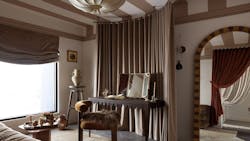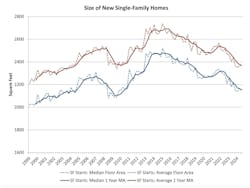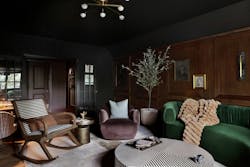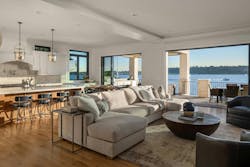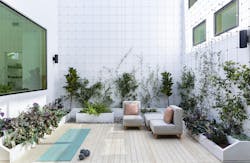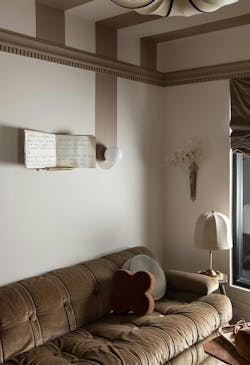Design trends shift every year, it seems, with a mishmash of stark and subtle changes influenced by myriad factors, some more controllable or influential than others. The shifts are easy enough to follow, but exceedingly tough to bet on.
"The problem with design trends," says award-winning lifestyle designer Letty Allen, owner of Mature Transitions by Design in Noth Barrington, Ill.,” is that they tend to be temporary.”
Navigating the mercurial waters of design requires context and an understanding of the physics and more specifically the mechanics of human preferences. It requires experience as much as taste … which is why we enlisted a trio of renown residential architects and designers to explain five ways homes are likely to change (or stay the same) in 2025.
1. Doing More in Less
“Homes have been shrinking,” says Jaime Matheron, principal/senior architect at Dahlin Architecture | Planning | Interiors in the firm’s Pleasanton, Calif., office. “At the same time, we need our homes to do more.”
She’s not wrong. The median size of a new, single-family home was 2,158 square feet last year, a 15-year low (see chart), even while more than 20 million people continue to work remotely, both according to U.S. Census Bureau data.
A demand for flexibility, Matheron says, is leading homeowners to embrace what she describes as “the loveliness of less.”
“It’s leaning into things being the right size, being functional, being flexible,” Matheron says. “It’s embracing the opportunities to do more with less.”
In her own work, Matheron is seeing that trend translate into more flexible, intentional spaces, such as more multi-generational suites and accessory dwelling units (ADUs) to host long-term or live-in guests that also could easily serve as revenue-generating rooms for rent. That change is impacting the function of even the most basic rooms of a house.
“We’re seeing more spaces prioritized for gathering,” adds Matheron, describing kitchens where functional zones have been created to keep certain areas free for interaction. “We’re seeing generous walk-in pantries and some of the kitchen’s typical functionality, like cooking, especially in larger homes, might be relocated to another space that’s a little more tucked away.”
Validating her observations, the 2025 Kitchen Trends Report from the National Kitchen & Bath Association (NKBA) of more than 520 industry professionals found that “66% said walk-in pantries and butler’s pantries will be popular in the next three years."
2. A Place for Warmth and Comfort
Growing expectations for functionality and flexibility, Matheron says, are closely tied to the home being seen as a sanctuary. “It’s becoming a place to get away from a stressful world,” leading her and other designers to emphasize spaces to be cozy and warm retreats.
Ginger Curtis, founder and CEO of Urbanology Designs in North Richland Hills, Tex., who authored “Beauty By Design” has noticed this trend shifting color preferences in response, with neutrals evolving into richer, moodier tones of deep chocolate browns, smokey charcoals, rich taupe, and velvety olives, she says.
“These shades feel luxurious and grounding, perfect for creating spaces that cocoon and comfort,” Curtis says. “To keep it dynamic, we’ll see unexpected pairings like earthy neutrals layered with pops of saturated citron or rich burgundy.”
3. An Emphasis on Health and Wellness
In many ways, the emphasis on comfort and sanctuary indicates a broader focus on health and wellness, a trends Allen is happy to see emerging alongside just the visual appeal of a space or home.
“Living spaces are increasingly being recognized as environments that can support physical and mental health,” she says, resulting in lower stress and strengthened immune systems.
Allen is working that concept into her designs in a variety of ways, starting with the bathroom.
“What better location is there to proactively continue to build a healthy home?” Heated floor tiles and built-in bench seats offer an upgraded level of relaxation, while a “new respect” for lighting serves the double function of eliminating shadowy areas and adding to a healthy interior by layering ambient, accent and task lighting fixtures, she says.
Better lighting also has the ability to increase the body’s natural production of melatonin, she adds. “Programmed LED lighting can now offer the circadian stimulus to end the disruption of the sleep-wake cycle.”
Matheron sees that same desire for better lighting extend to enabling more natural lighting, especially as it relates to custom and larger homes.
“We’re pushing boundaries of large glazing, using large glass doors, sliding systems and windows to really open up the home,” she says.
4. A Growing Connection to Nature
It’s all part of a continued effort to connect the home to the outdoors and nature—another aspect of the increased emphasis on health and wellness.
“Indoor-outdoor living continues to be big,” Matheron says, referencing outdoor areas that function as living spaces and connect to the interior as well as a continued focus on biophilic design, which saw a relatively major surge in attention among designers and consumers during the pandemic.
Allen specifically mentions that biophilic design for interior spaces has been shown to reduce stress, which a 2020 study by Science Direct entitled “Effects of Biophilic Indoor Environment on Stress and Anxiety Recovery” supports.
With that, adding live plants can soften the hard architectural lines of a space and provide a connection to nature, says Allen.
It’s a trend that’s been building for several years now, but as Curtis explains, “2025 will bring a deeper connection to craftsmanship and sustainability.” She expects that lime-washed walls, highly conveyed reclaimed materials, and hand-finished details will be particularly popular this year.
5. The Rise of Nostalgia
Along with increasing consumer demand for flexibility and functionality—a space to live and work but also relax and recover—designers are also seeing an increase in the home’s character.
“Cool, sterile, and depersonalized spaces are losing ground to wallcoverings that provide a backdrop for highlighting objects and framed photos of meaningful experiences,” says Allen.
NKBA’s report revealed that 29% of respondents prefer a clean and classic white kitchen while the vast majority (71%) prefer a personalized design that includes colors that showcase the owners’ personality.
“It’s a way to inject ‘personality’ and ‘nostalgia’ into spaces,” says Curtis. “It makes interiors feel less serious and more expressive.”
Nostalgia, in particular, appears to be gaining considerable ground.
“The bold shapes and vibrant colors of the ‘70s and ‘80s are coming back, but with a refined twist,” Curtis says. Think rounded sofas, checkerboard floors, and cheerful palettes paired with luxe materials like smoked glass and brushed brass.
Other design pros report similar observations in the NKBA report, with 52% agreeing that the bright colors and earth tones of the 1970s will be popular this year, while nearly half predict that the muted, mid-century modern aesthetic of the 1950s will also see a resurgence.
